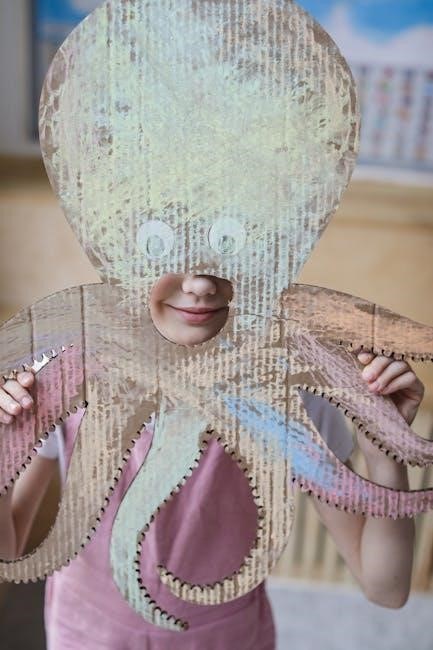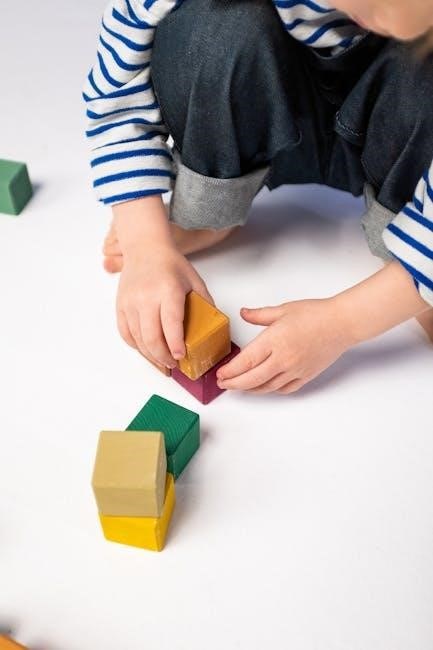GDScript is Godot’s built-in scripting language, designed for ease of use and integration with the engine. It simplifies game development with a Python-like syntax;
Learning GDScript is essential for creating games in Godot, as it provides direct access to engine functionality and enables rapid prototyping and development.
Godot 4 is a powerful, open-source game engine that supports both 2D and 3D game development. Its versatility and community-driven ecosystem make it a popular choice.
1.1 Overview of GDScript as Godot’s Built-In Language
GDScript is Godot’s built-in scripting language, designed to be easy to learn and use. It features a syntax similar to Python, making it accessible to newcomers. GDScript is tightly integrated with the Godot Engine, providing direct access to its APIs and features. This language is dynamically typed, allowing for flexibility and rapid prototyping. It supports object-oriented programming concepts like classes, inheritance, and signals. GDScript is optimized for game development, enabling developers to create logic for nodes, scenes, and behaviors efficiently. Its simplicity and power make it an ideal choice for both beginners and experienced developers.
1.2 Importance of Learning GDScript for Game Development
Mastering GDScript is crucial for harnessing the full potential of the Godot Engine. It enables developers to create game logic, interact with scenes, and utilize engine features effectively. GDScript’s simplicity accelerates the learning process, allowing beginners to quickly develop functional games. Understanding GDScript is essential for building custom mechanics, scripting behaviors, and optimizing performance. It also enhances collaboration, as it’s widely used within the Godot community. By learning GDScript, developers can create complex, engaging games efficiently, making it a vital skill for anyone aiming to develop games with Godot. Its versatility and ease of use make it indispensable.
1.3 Benefits of Using Godot 4 for Game Development
Godot 4 offers numerous advantages for game development. As an open-source engine, it provides free access to advanced tools and features. Its cross-platform support enables deployment on multiple devices, expanding your audience. The engine’s node-based architecture simplifies scene management and scripting. Godot 4 also includes a built-in animation system, physics engine, and particle effects, streamlining development. Its large community and extensive documentation ensure robust support. Additionally, Godot 4’s customization options allow developers to tailor workflows to their needs, making it an ideal choice for both indie and professional game creators. Its versatility and ease of use enhance productivity.

Setting Up the Development Environment
Welcome to the section on setting up your development environment. Properly configuring Godot 4 and GDScript is essential for a smooth and efficient workflow.
2.1 Installing Godot Engine 4
Installing Godot Engine 4 is straightforward. Visit the official Godot website and download the appropriate version for your OS. Follow the installation instructions carefully. Ensure all dependencies are met for optimal performance.
2.2 Configuring the Godot Editor for GDScript
After installing Godot Engine 4, configure the editor for GDScript by enabling essential settings. Navigate to Project Settings and ensure GDScript is selected as the default script language. Enable Auto Completion for efficient coding and explore script templates for quick project setup.
Adjust the editor theme and syntax highlighting to improve readability. Familiarize yourself with the Script tab for debugging and the Node system for scene management. Install plugins like GDScript Debugger for enhanced troubleshooting. These configurations streamline your workflow, making it easier to develop games with GDScript in Godot 4.
2.3 Essential Tools and Plugins for Efficient Development
To enhance your GDScript workflow, utilize essential tools and plugins. The GDScript Debugger is crucial for identifying and fixing errors in your code. Install the Code Completion plugin to speed up scripting with intelligent suggestions. Additionally, the Scene Template plugin helps you create common game structures quickly. For visual scripting, VisualScript is a valuable alternative. Explore the Asset Library for pre-built assets to save time. Lastly, the Project Manager plugin streamlines project organization and deployment. These tools and plugins optimize your development process, making it more efficient and enjoyable.

Basic Syntax and Programming Concepts in GDScript
GDScript’s syntax is simple and Python-like, making it easy to learn. Variables store data, and control flow statements like if-else and for loops manage execution. Functions encapsulate reusable logic, while basic operators perform arithmetic and comparisons. Understanding these concepts is foundational for scripting in Godot.
3.1 Variables and Data Types in GDScript
In GDScript, variables store data, and understanding their types is crucial. Common data types include int for integers, float for decimals, String for text, and bool for true/false values. Arrays and dictionaries store collections, while Vector2 and Vector3 handle coordinates. Variables are declared using var or onready, and GDScript’s dynamic typing simplifies variable management. Proper use of data types ensures efficient and error-free coding, making them fundamental for scripting in Godot.
3.2 Operators and Control Flow Statements
In GDScript, operators are used to perform arithmetic, comparison, and logical operations. Common operators include +, -, *, /, ==, !=, &&, and ||. Control flow statements like if, else, for, while, and match enable conditional execution and loops. These constructs allow developers to create dynamic behavior, handle user input, and manage gameplay logic. Proper use of operators and control flow ensures efficient and responsive code, making them fundamental for scripting interactive elements in Godot 4.
3.3 Functions and Scope in GDScript
In GDScript, functions are reusable blocks of code defined using the func keyword; They enhance code organization and reusability, making scripts more maintainable. Functions can accept parameters and return values, enabling modular logic. Scope determines variable accessibility, with local variables declared inside functions being exclusive to them. Global variables, declared outside functions, are accessible throughout the script. Understanding scope is crucial for managing variable interactions and preventing unintended behavior. Proper use of functions and scope is essential for writing clean, efficient, and bug-free code in GDScript.

Object-Oriented Programming in GDScript
Object-oriented programming in GDScript involves creating classes, using inheritance, and defining methods, which helps in organizing and reusing code effectively for game development in Godot 4.
4.1 Classes and Inheritance in GDScript
GDScript supports object-oriented programming through classes and inheritance, enabling code reuse and organization. A class defines a blueprint for objects, encapsulating properties and methods. Inheritance allows one class to extend another, inheriting its attributes and behaviors. This promotes modular code and simplifies complex game structures. For example, a Player class can inherit from a Character class, adding specific abilities while maintaining core functionality. This feature is essential for managing large projects and creating hierarchical relationships between game entities in Godot 4.
4.2 Methods and Properties in GDScript
In GDScript, methods are functions defined within a class to perform specific actions, while properties are variables that define the characteristics of an object. Methods can be called on instances of a class, enabling dynamic behavior. Properties allow customization of object states, such as position or speed. For example, a Player class might have a move method and a health property. This structure promotes modularity and makes it easier to manage complex game logic in Godot 4.
func move(direction):
position += direction
This code demonstrates a method that updates an object’s position based on input.
4.3 Signals and Events in Godot 4
In Godot 4, signals and events are used to communicate between nodes and scripts. Signals are emitted by nodes when specific actions occur, such as a button being pressed or a collision detected. These signals can be connected to functions, enabling responsive and modular code. Events are similar but are typically used for input actions like keyboard or mouse interactions. By leveraging signals and events, developers can decouple code logic, making it easier to manage and modify behavior. For example, connecting a button’s pressed signal to a function ensures the UI responds dynamically to user input.

button.connect("pressed", self, "_on_button_pressed")
This approach promotes clean and scalable code structure in game development.

Building a 2D Game with Godot 4
Start by creating a new project and organizing scenes. Implement player movement using GDScript, then add enemies and collision detection for interactive gameplay.
5.1 Creating a New Project and Scene Structure
To begin, launch Godot 4 and select “New Project” from the project list. Choose a project name and location, then select “2D” as the game type. Godot will create a basic project structure.
Organize your scenes by creating a main scene for the game world. Use nodes like Node2D or SpatialNode to structure your game objects hierarchically. Attach scripts to nodes using GDScript for functionality.
Utilize the scene tree to manage game entities, such as players, enemies, and UI elements. Proper organization ensures scalability and easier debugging as your project grows.
5.2 Implementing Player Movement and Controls
Start by creating a player node and attaching a KinematicBody2D or RigidBody2D for physics-based movement. Use GDScript to handle input actions like keyboard or controller inputs.
Define movement variables such as speed, velocity, and acceleration. Apply forces or velocities to the player using move_and_slide or apply_impulse for realistic movement.
Add conditional checks for ground state and jumping mechanics. Implement smooth transitions between movement states using GDScript’s built-in physics functions.
Test and refine controls to ensure responsiveness and fluid gameplay. Use debugging tools to identify and fix issues in real-time.
5.3 Adding Enemies and Collision Detection
Create enemy nodes with GDScript scripts to define AI behaviors and movement patterns. Use Area2D or CollisionShape2D for detection zones.
Implement collision detection using Godot’s built-in signals like body_entered or area_entered. Handle interactions between players and enemies programmatically.
Optimize enemy AI by using state machines or behavior trees. Debug collision logic using Godot’s Remote Debugger for real-time insights.
Ensure enemies react to player actions and environmental obstacles. Test and refine collision responses for smooth gameplay.

Advanced Topics in GDScript and Godot 4
Master advanced techniques like state machines, performance optimization, and networking in Godot 4. Enhance your game mechanics and leverage GDScript for complex, scalable projects.
6.1 State Machines and Behavior Trees
State machines and behavior trees are advanced tools for managing complex game logic. State machines enable efficient transitions between game states, while behavior trees structure AI decision-making. GDScript integrates seamlessly with Godot’s visual state machine editor, allowing developers to create dynamic, interactive systems. Behavior trees offer a hierarchical approach to AI behavior, making it easier to implement sophisticated NPC actions. Together, these tools enhance scalability and reusability in game development, ensuring efficient and organized code structure. Mastering these concepts is crucial for creating advanced, responsive, and engaging game mechanics in Godot 4.
6.2 Optimizing Performance in Godot 4
Optimizing performance in Godot 4 is crucial for ensuring smooth gameplay and efficient resource usage. Start by reducing unnecessary node counts and leveraging batching for sprites and meshes. Optimize animations by using sprite sheets and minimizing frame counts. In GDScript, avoid heavy computations in loops and utilize built-in functions for performance. Profiling tools help identify bottlenecks, while proper scene management reduces memory overhead. Implementing physics optimizations, such as disabling unused collision layers, further enhances performance. By following these strategies, developers can create visually stunning and responsive games without compromising on functionality or user experience in Godot 4.
6.3 Using GDScript for Networking and Multiplayer
GDScript enables seamless integration of networking and multiplayer features in Godot 4. Utilize built-in classes like Network and Multiplayer to manage connections and synchronize data. Implementing client-server architectures is straightforward with GDScript’s event-driven approach. Use remote procedures and signals to communicate between nodes across the network. For real-time interactions, leverage WebRTC or ENet plugins. Debugging network issues is simplified with Godot’s built-in debugger. By mastering GDScript’s networking capabilities, developers can create engaging multiplayer experiences, ensuring smooth communication and efficient data handling in their games.
Debugging and Testing Your Game
Master debugging techniques using Godot’s built-in debugger to identify and fix issues in your GDScript code. Implement rigorous testing practices to ensure game stability and performance.
7.1 Using the Godot Debugger for GDScript
The Godot Debugger is an essential tool for identifying and fixing issues in your GDScript code. It allows you to set breakpoints, step through your code line by line, and inspect variables in real-time. By running your game in debug mode, you can monitor script execution and catch errors as they occur. The debugger also provides detailed information about the current state of your game, helping you pinpoint problems quickly. Regular use of the debugger will improve your ability to troubleshoot and refine your game efficiently. Practice using these tools to enhance your debugging skills and ensure a smooth gaming experience.
7.2 Best Practices for Testing and Iteration
To ensure a robust game development process, adopt best practices for testing and iteration. Regularly test individual components, such as scripts and scenes, to identify and fix issues early. Use automated testing tools to streamline repetitive checks and maintain code quality. Implement version control systems like Git to track changes and collaborate effectively. Conduct playtesting sessions to gather feedback and refine gameplay mechanics. Iterate based on test results, prioritizing bug fixes and performance optimizations. Documenting your testing process helps maintain consistency and accelerates troubleshooting. By integrating these practices, you can enhance the stability and quality of your game while speeding up development cycles.
7.3 Common Errors and How to Fix Them
When developing with GDScript in Godot 4, common errors include syntax mistakes and node connection issues. Ensure proper indentation and correct use of colons and commas. Check for typos in variable names to avoid reference errors. For node connections, verify signal names and parameter types. Use the Godot Debugger to identify runtime errors and set breakpoints for deeper analysis. Review console logs to pinpoint issues and follow error messages for guidance. Regularly test scripts and scenes to catch mistakes early. By addressing these errors systematically, you can resolve them efficiently and maintain a smooth development workflow.

Polishing and Publishing Your Game
Polishing involves refining visuals, audio, and mechanics for a professional finish. Publish by exporting to platforms like Windows, macOS, or mobile, ensuring compatibility and performance.
8.1 Adding Visual and Audio Effects
Enhance your game with visually appealing effects like animations, particle systems, and lighting. These elements create a immersive experience, making your game more engaging. Use Godot’s built-in tools to design stunning visuals that align with your game’s theme. Additionally, incorporate high-quality audio effects, such as background music, sound effects, and voiceovers, to further enrich gameplay. Properly balancing these elements ensures a polished and professional finish, making your game stand out to players. These touches are crucial for creating a memorable and enjoyable gaming experience.
8.2 Exporting Your Game for Multiple Platforms
8.3 Marketing and Distributing Your Game
Marketing and distribution are critical steps in sharing your game with the world. Identify your target audience and create a compelling trailer, screenshots, and descriptions. Leverage social media, forums, and gaming communities to build hype. Distribute your game through platforms like Steam, GOG, the App Store, Google Play, and itch.io. Consider creating a website or blog to centralize updates and downloads. Engage with players through updates, patches, and community feedback to foster loyalty. Effective marketing strategies and distribution channels ensure your game reaches its full potential and attracts a loyal player base.

Community and Resources for Learning
The Godot community offers extensive support through forums, tutorials, and documentation. Engage with developers on Discord, explore GDQuest for learning materials, and utilize community-driven projects for inspiration and problem-solving.
9.1 Official Godot Documentation and Tutorials

The official Godot documentation provides comprehensive guides for mastering GDScript and the engine. Tutorials cover syntax, engine APIs, and practical examples, making it an invaluable resource for both beginners and advanced developers. The documentation is regularly updated to reflect new features and best practices, ensuring users stay current with Godot 4.
9.2 Community Forums and Discord Channels
Community forums and Discord channels are vital resources for learning GDScript and Godot 4. Platforms like the Godot Community Forums and the official Discord server offer direct support, where developers can ask questions, share knowledge, and collaborate. These spaces foster a sense of belonging and provide real-time feedback, helping newcomers overcome challenges. Discussions often cover troubleshooting, best practices, and innovative approaches to game development. Engaging with these communities not only enhances learning but also keeps developers updated on the latest trends and updates in the Godot ecosystem.
9.3 Recommended Books and Courses for GDScript
Several books and courses are available to help learners master GDScript and Godot 4. Titles like Learning GDScript by Developing a Game with Godot 4 provide comprehensive guides, combining theory with practical projects. Online platforms offer courses that cater to all skill levels, from basics to advanced topics. These resources often include step-by-step tutorials, code examples, and real-world applications, ensuring a well-rounded learning experience. Many courses are community-recommended, making them trusted sources for gaining proficiency in GDScript and game development within the Godot ecosystem.
Mastery of GDScript and Godot 4 requires consistent practice and experimentation. Keep building projects, exploring advanced features, and engaging with the community for continuous growth and improvement.
10.1 Recap of Key Concepts Learned
Throughout this guide, you’ve learned the fundamentals of GDScript and Godot 4, from basic syntax to advanced game development techniques. Key concepts include variables, control flow, functions, and object-oriented programming principles like classes and inheritance. You’ve also explored Godot’s scene system, signals, and practical applications like player movement and collision detection. Additionally, the importance of debugging, optimization, and community resources was emphasized. These skills provide a solid foundation for creating engaging 2D and 3D games, preparing you to tackle more complex projects and continue growing as a game developer.
10.2 Encouragement to Continue Learning and Experimenting
Congratulations on reaching this milestone! Learning GDScript and Godot 4 is a journey, and consistent practice is key to mastering game development. Encourage yourself to experiment with new features and tools, as hands-on experience is invaluable. Join community forums and Discord channels for feedback and inspiration. Start small projects to apply what you’ve learned and gradually tackle more complex challenges. Stay curious, explore Godot’s documentation, and embrace the joy of creation. Every project, no matter how simple, is a step toward becoming a skilled game developer. Keep pushing your boundaries and enjoy the process of growth!
10.3 Final Tips for Mastering GDScript and Godot 4
Mastering GDScript and Godot 4 requires consistent practice and a willingness to experiment. Start by building small projects to apply what you’ve learned. Use the Godot Debugger to identify and fix errors efficiently; Optimize your code and scenes for better performance. Explore advanced features like state machines and behavior trees to enhance your game design. Stay updated with the official documentation and community resources for the latest tips and techniques. Engage with the Godot community for feedback and inspiration. Always test your games on different platforms to ensure compatibility. Finally, embrace challenges and persist through setbacks—every obstacle is an opportunity to grow as a developer.
Leave a Reply
You must be logged in to post a comment.